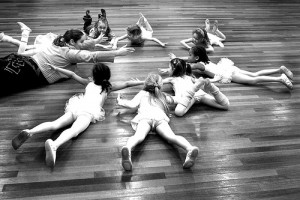“The composer must use this element of construction to link all the parts and effectively create a whole. Transitions are very important and perhaps the most difficult aspects of the composition.” – Jacqueline M. Smith-Autard on transition in Dance Composition
Transitions in choreography are very similar to transitions in a dance class.
 They are the connection or link from one section, thought or idea to the next and should make sense in the overall theme.
They are the connection or link from one section, thought or idea to the next and should make sense in the overall theme.
A choreographer or teacher might have a reason for an abrupt transition versus a smooth one, a quick transition versus a slow one. As in choreography, when teaching, make sure you choose how to get from A (sitting on the floor) to B (standing in the corner of the room).
This makes all the difference in classroom management, focus and flow of the class.
Use transitions as another time to learn and explore, to connect the sections of the class or to have the students demonstrate their creativity. They’ll become your favorite teaching tool and the students’ favorite part of class.
Transition Ideas
Classroom management does not have to do with having tight control of the class. It has to do with keeping the class focused, involved and engaged in the activities.
- Start the class with a special way of entering the space.
This focuses the children. They click into dance mode even before they enter the room. An empty studio space can entice little ones to run wild. If they enter the classroom with specific instructions, you have already captured their attention. The directions can be, “Enter with your favorite step and sit it the center of the room.” or “It is very windy today. Show me how the wind blew you here!” This also gives you a chance to give each student attention.
little ones to run wild. If they enter the classroom with specific instructions, you have already captured their attention. The directions can be, “Enter with your favorite step and sit it the center of the room.” or “It is very windy today. Show me how the wind blew you here!” This also gives you a chance to give each student attention. - Music is much more than accompaniment.
It can be a fantastic transitioning tool. Investing in a tambourine, shaker or other small hand held instrument can be a very effective way of ending one section of class and starting the next. A big clap of the tambourine can signal freeze, a light shake can mean tip toe, and a repetitive tap can mean march. The class can even decide how they want to move from one part of the space to another (like from the floor to the corner of the room) and what the sound should be.
effective way of ending one section of class and starting the next. A big clap of the tambourine can signal freeze, a light shake can mean tip toe, and a repetitive tap can mean march. The class can even decide how they want to move from one part of the space to another (like from the floor to the corner of the room) and what the sound should be. - A special song for a special task.
Does your class need to change their shoes, take their shoes off, get dressed or undressed at some point during class? This is a transition. Use this time to teach and focus the kids. Sing a song while they change shoes or change clothes. The beginning of the song signals time to change and the end of the song lets them know it is time to finish the task. This also helps the children stay connected to their job and feel a sense of time. The song can change with the seasons, be about different animals, or speed up and slow down. The children can even sing along. Once a child is done with the task he or she can dance to the song and freeze when the song is over.
during class? This is a transition. Use this time to teach and focus the kids. Sing a song while they change shoes or change clothes. The beginning of the song signals time to change and the end of the song lets them know it is time to finish the task. This also helps the children stay connected to their job and feel a sense of time. The song can change with the seasons, be about different animals, or speed up and slow down. The children can even sing along. Once a child is done with the task he or she can dance to the song and freeze when the song is over. - Sometimes you need an extra moment.
There is a natural transition in the class when you finish teaching your students a new dance step and are ready to practice the routine with music. Usually it does not take more than a few seconds. The children usually experience this by standing still and waiting for the music to begin. But what happens when the music does not go on and you need to take a few minutes to analyze why the CD player is not working? I like my students to create a starting shape while they wait for the music. If I have trouble with the music, I can ask them to change their shapes’ level or move around the space in their shapes. The children stay invested in the moment and my technical difficulty does not become a classroom difficulty. The point is when children stay engaged they are less likely to get bored or misbehave. It is easier to maintain a child’s focus then try to get it back.
a new dance step and are ready to practice the routine with music. Usually it does not take more than a few seconds. The children usually experience this by standing still and waiting for the music to begin. But what happens when the music does not go on and you need to take a few minutes to analyze why the CD player is not working? I like my students to create a starting shape while they wait for the music. If I have trouble with the music, I can ask them to change their shapes’ level or move around the space in their shapes. The children stay invested in the moment and my technical difficulty does not become a classroom difficulty. The point is when children stay engaged they are less likely to get bored or misbehave. It is easier to maintain a child’s focus then try to get it back. - Transitioning to the bathroom.
Sometimes children have to go to the bathroom in the middle of class. If one child asks then one by one all the children have the urge to go to the bathroom. Have the children to signal their need to go to the bathroom in sign language. Hold your hand in a fist and put your pointer finger over your thumb (like when you play the game “I got your nose!”). Have them move their wrist side to side. This is the sign for bathroom. Then all you have to do is nod yes or no. Transitioning kids in and out of the room becomes seamless and less distruptive.
then one by one all the children have the urge to go to the bathroom. Have the children to signal their need to go to the bathroom in sign language. Hold your hand in a fist and put your pointer finger over your thumb (like when you play the game “I got your nose!”). Have them move their wrist side to side. This is the sign for bathroom. Then all you have to do is nod yes or no. Transitioning kids in and out of the room becomes seamless and less distruptive. - A way to say goodbye.
Having a special transition to exit class can give you an opportunity to once again give each student his or her own moment with you. I usually sing a goodbye song using each child’s name in the song. It helps me connect with each child before the class ends. I remember taking jazz class when I was younger and we leapt out the door. There is no wrong or right choice. Just pick something that works with the flow and style of your class.
give each student his or her own moment with you. I usually sing a goodbye song using each child’s name in the song. It helps me connect with each child before the class ends. I remember taking jazz class when I was younger and we leapt out the door. There is no wrong or right choice. Just pick something that works with the flow and style of your class.
Whatever your choices are for these transition periods in class, it is important to be consistent, especially for little ones. A sense of predictability is helpful to maintain a focused and attentive group. Change up the movement activities but keep your transitions from one task to the next the same.
By the end of the year you won’t have to lead them into their transitions. They’ll know their cue!
What types of transitions do you use when you teach? I would love to hear your ideas!
Stacey Pepper Schwartz is the Founder and Director of Leaping Legs Creative Movement Programs. The focus of Leaping Legs is to help people regardless of age, experience or ability, become educated about their movement potential, develop kinesthetic awareness, and become more physically fit and healthy together as a family, and community. Leaping Legs promotes its goal through its original Up Down & All Around DVD, teacher training, and school and community workshops. The Up Down & All Around DVD received Dr. Toy’s 100 Best Children’s Products 2009 Award and 10 Best Active Products 2009 Award. The DVD has also been featured in many magazines including Dance Teacher and Dance Retailer News. In its August 2009 issue, Dance Teacher called the DVD “an essential tool for teaching the fundamentals of movement with daily adult-child interactions.” Come visit www.leapinglegs.com to learn more about Stacey and her programs.


